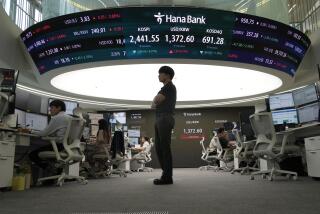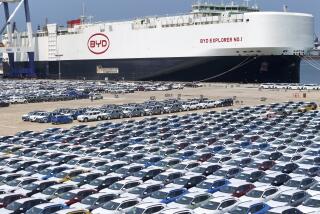S. Korea Targets North America for Big Push in Car Exports
- Share via
SEOUL, South Korea — This is a country where car ownership is still only a dream for the average citizen. Only one South Korean in 40 owns a car, and most of the automobiles here are taxis or company owned. Yet, despite this limited domestic market, South Korea’s fledgling auto industry stands on the brink of a major expansion.
The industry, which now has the capacity to produce 500,000 vehicles, plans to double that to 1 million by 1987--about as many cars, trucks and buses as are now operating in the entire country. But the growth is aimed at overseas markets--the United States and Canada in particular--and not at Korean buyers.
South Korea is going to be “a factor in the world automobile market,” predicts Ahn Chong Sang, executive director of Samsung Co., an auto parts exporter.
Already, exports will top 100,000 units this year, more than the whole industry could produce a scant three years ago.
Although South Korea “cannot imitate the success of Japan” in car exports, Ahn says, it will be making an auspicious entry into the American market next year. Hyundai Motor Co. reportedly plans to ship 100,000 cars to the United States in 1986. And in 1987, South Korea’s three established auto firms--Hyundai, Daewoo and Kia--expect to be exporting a total of 385,000 cars to the United States and Canada.
Some growth is expected in the domestic market, but Lee Soo Jang, director of overseas trade for Kia Motors, says it would be wrong to expect domestic demand to match the capacity of factories that are being built.
“Our investment policies will have to be based on exports,” he says.
That’s because the prospects for a surge in domestic demand are slim. The government, apparently hewing to the old belief that a car is a luxury item for the rich, shows no signs of lowering either taxes or surcharges on cars.
Those charges amount to as much as 53% of the production cost of a car here, American analysts say.
Only 109,725 passenger cars were sold at home in 1984.
(Tariffs on imports are even tougher, so prohibitive that the South Korean auto market is effectively closed to foreign producers.)
“Taxation on cars is a very serious public policy matter, which won’t easily be settled,” says Ahn, the Samsung executive.
Because of taxes, a subcompact here sells for about $6,000. This, says an executive of one auto firm who asked not to be identified, is almost double the price that his firm plans to ask for its car in the United States.
The American analysts, who also asked not to be identified, estimate that, in 1987, South Korea will produce as many as 500,000 more autos than the domestic market can consume. Therefore, one analyst said, exports “are likely to number significantly higher than South Koreans would like to admit and are likely to be given strategic importance (by the government).”
Lee, the Kia executive, says that, to support decisions already made to expand plant capacity, “by 1990 we must achieve exports of at least 500,000 vehicles,” including trucks and buses. Capacity of the three firms that year is expected to reach 1.64 million units--950,000 for Hyundai, 450,000 for Kia and 240,000 for Daewoo.
The American analysts here agree that the sheer size and potential productive capacity of the new plants will force the three firms to look to exports, not the home market, to sell their products.
However, the problems involved in breaking into the American market promise to be immense. Only Hyundai has much experience as an exporter. The entry of Daewoo and Kia into the American market will mark the first time that auto makers without significant exporting experience have picked the U.S. market for their first major effort.
Slipshod production techniques that were good enough to satisfy South Korea’s protected domestic market are causing headaches for the plant foremen supervising production for export, the American analysts say.
“Door or hood fit means little to workers who have never owned or driven a car,” said one of the local American analysts.
In addition, only limited use of assembly-line robots are planned at three factories that the companies are building or expanding.
“None of the firms will be engaged in leading-edge production in the near future,” one of the Americans said. He added that, until the South Koreans catch up with American and Japanese technology, “their labor force will determine the industry’s future.”
Relatively Low Wages
This country’s relatively low wages, however, will give the Korean makers a comfortable competitive edge. Including bonuses and fringe benefits, the average assembly-line worker here is paid the equivalent of only $2.09 an hour--and willingly puts in a 50-hour workweek.
Hyundai, the first in the export field, is being cautious in its approach to exporting to the United States. The company, which is part of South Korea’s largest business conglomerate, reportedly will concentrate initial sales efforts on the East and West coasts of the United States, where 100 dealers have been recruited.
Company officials refused to be interviewed but, according to the American observers here, it expects to land its front-wheel-drive subcompact, called the Pony Excel here, in the United States in February.
Soon after introducing the Pony Excel, Hyundai plans to bring over its mid-size family car--called the Stellar here--according to the American analysts.
Chung Se Yung, Hyundai’s president, said last week in Detroit that the firm will export its front-wheel-drive subcompact in three models. He said exports will begin “next year.”
The Americans predict that, in 1987, Hyundai will export 200,000 cars to United States and Canada.
Hyundai, which began exporting a few passenger cars in the mid-1970s, mainly to the Middle East, scored its first big export success last year when it entered the Canadian market with its Pony II. Because of its 25,000 sales in Canada last year, Hyundai more than doubled its global exports--to 48,052 cars.
This year, the Pony II and the Stellar, with combined sales of 39,977 through July, have made Hyundai the best-selling import firm in Canada, passing both Honda and Toyota. For the year, Canadian sales are expected to reach 55,000.
Honda and Toyota are both believed to have decided to build assembly plants in Canada, at least partly to cope with Hyundai. Keeping abreast, Hyundai announced last Thursday that it, too, will build a Canadian assembly plant to produce 100,000 units by 1990.
The American analysts say that Daewoo will ship 100,000 cars and Kia 85,000 cars to the U.S. market.
Daewoo, a 50-50 joint venture with General Motors, plans to start shipping in February, 1987, with a target of as much as 100,000 cars a year for sale in Pontiac showrooms. The car will be a version of GM’s Opel Start, which is sold in Europe. Last year, Daewoo exported only 444 passenger cars.
Kia Motors, which was excluded by government edict from the manufacture of passenger cars in 1980, was given permission last year to re-enter the field in 1987. It now makes only buses, vans and trucks.
Lee, the Kia executive, said Ford will buy 85,000 cars beginning in 1987. A new model, with engine displacement of 1,000 to 1,300 cubic centimeters, is being developed jointly with Mazda of Japan for sale under the Ford name. A contract for the exports has already been signed with Ford, Lee said.
Manufacturing under license from Mazda, which shares a 10% equity investment with C. Itoh, a large Japanese trading firm, Kia now operates only a one-shift operation with a capacity of 120,000 vehicles a year. The firm is building a new assembly line, at a cost of $230 million, which is expected to double capacity by 1987.
Kia-Ford Talks
Lee said adjustments on assembly lines could raise Kia’s total capacity to 300,000 units a year by 1987. Kia also has decided to build a new plant, which will add another 200,000 units of capacity by 1990, Lee said.
He said Kia wants to diversify its sources of technical assistance and is talking with Ford about an equity investment in Kia. He also said the firm is interested in adding a third partner through a tie-up with a European firm, which he did not name.
Kia’s expansion plans are typical of the South Korean industry’s ambitions.
Hyundai has already begun a reclamation project at Asan Bay to prepare the way for construction of a second auto factory with a planned capacity of 500,000 units a year. At present, Hyundai’s only plant is at Ulsan, on the southeast coast. Capacity there is being expanded to 450,000 units a year from 300,000, a project to be completed by early 1987, the American analysts said.
Daewoo is also expanding its plant--to a planned capacity of 240,000 cars a year--a project that is expected to be completed by the middle of next year. It will then start selling a domestic version of its new car.
In the wings are Chrysler and Samsung, the auto parts firm here, which have set up a joint parts procurement office that was opened here in July. Ahn, the Samsung executive, said the firm expects next year to sell Chrysler parts worth $10 million to $20 million.
Joint production of parts or passenger cars, or both, is a “possibility for the future,” Ahn said.
The major obstacle to Samsung going into auto production is the Ministry of Trade and Industry, which, according to Lee of Kia Motors, wants to keep the industry from repeating past mistakes of over-investment. The ministry has put a limit of three on the number of auto makers in South Korea, and it has given no hint that it will remove that limit.
But, according to the American analysts, if Chrysler and Samsung can present an attractive package to the government, joint production could begin by the end of the 1980s. If production is authorized, Chrysler can be expected to import about 100,000 passenger cars a year, the analysts said.
Ahn acknowledged that Samsung is studying joint production with Chrysler within a time framework that calls for factory construction starting “around 1989 or 1990,” but he said the firm has not made a decision or presented a proposal to the government.
At least two other Korean firms are said to be hoping to go into auto manufacturing. The American analysts identified them as Dong-A Motors, which produces a limited quantity of utility vehicles and trucks, and the Lucky-Gold Star conglomerate, which is not now involved in the auto business.
Even before the Chrysler-Samsung joint procurement venture gets moving, the flurry of activity has spurred a major surge in auto parts exports. Last year, parts exports rose by 46% to $197.7 million. Exports to North America were up 59%.
Auto parts exports are expected to be increased further under two joint ventures involving General Motors and Daewoo, which are building factories here.
More to Read
Sign up for Essential California
The most important California stories and recommendations in your inbox every morning.
You may occasionally receive promotional content from the Los Angeles Times.










